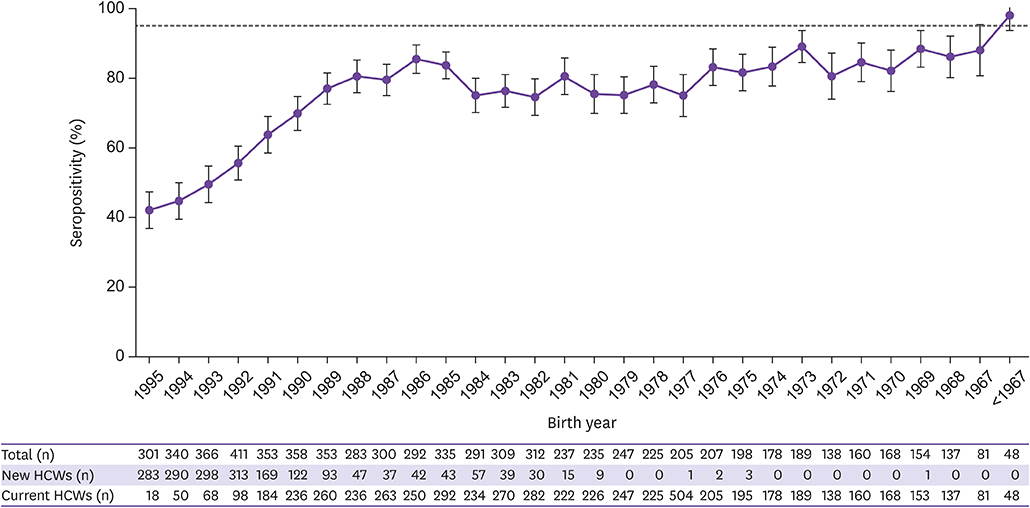Seroprevalence of Measles in Healthcare Workers in South Korea
- Affiliations
-
- 1Department of Infectious Diseases, Asan Medical Center, University of Ulsan College of Medicine, Seoul, Korea. kimsunghanmd@hotmail.com
- 2Office for Infection Control, Asan Medical Center, Seoul, Korea.
- KMID: 2442223
- DOI: http://doi.org/10.3947/ic.2019.51.1.58
Abstract
- There are only limited data regarding the seroprevalence of measles of healthcare workers (HCWs) in Korea. We evaluated the seroprevalence of measles in HCWs in a tertiary care hospital in Korea. A total of 7,411 HCWs born from 1952 to 1995 underwent antibody test. The overall seropositivity of measles was 73% (95% confidence interval, 72 - 74). The seropositivity of measles sharply declined from 85% in the 1986 birth cohort to 42% in the 1995 birth cohort, thus signifying pockets of under-immunity. Our data warrant the need for routine antibody tests, followed by measles vaccination or routine measles vaccination in young Korean HCWs.
MeSH Terms
Figure
Cited by 4 articles
-
Seroprevalence of mumps in healthcare workers in South Korea
Sun-Kyung Kim, Jiwon Jung, Sun Hee Kwak, Min Jee Hong, Sung-Han Kim
Clin Exp Vaccine Res. 2020;9(1):64-67. doi: 10.7774/cevr.2020.9.1.64.A Nationwide Survey on the Hospital Vaccination Policies in Korea
Sun Hee Park, Mi Suk Lee, Sung Ran Kim, Yee Gyung Kwak
J Korean Med Sci. 2020;35(12):. doi: 10.3346/jkms.2020.35.e76.Comparison of the Seroprevalence of Measles Antibodies among Healthcare Workers in Two Korean Hospitals in 2019
Yee Gyung Kwak, Je Eun Song, Gang-Bok Oh, In Hye Jeong, Chong Rae Cho, Namhee Kim, Hyeon Mi Yoo, Gyeong Min Yoo, Myung Jin Lee, Baek-Nam Kim
Infect Chemother. 2020;52(1):93-97. doi: 10.3947/ic.2020.52.1.93.Strategies for Minimizing Mealses Transmission in Korean Healthcare Facilities
Yong Chan Kim
Korean J Healthc Assoc Infect Control Prev. 2022;27(2):125-133. doi: 10.14192/kjicp.2022.27.2.125.
Reference
-
1. Kang JH, Yoo JH. The measles strikes back. J Korean Med Sci. 2019; 34:e59.
Article2. Kang HJ, Han YW, Kim SJ, Kim YJ, Kim AR, Kim JA, Jung HD, Eom HE, Park O, Kim SS. An increasing, potentially measles-susceptible population over time after vaccination in Korea. Vaccine. 2017; 35:4126–4132.
Article3. Choe YJ, Park YJ, Kim JW, Eom HE, Park O, Oh MD, Lee JK. An outbreak of measles in a university in Korea, 2014. J Korean Med Sci. 2017; 32:1876–1878.
Article4. Kim SK, Park HY, Kim SH. A third dose of measles vaccine is needed in young Korean health care workers. Vaccine. 2018; 36:3888–3889.
Article5. Korea Center for Infectious Disease Control (KCDC). Measles and rubella elimination and current status in Korea. Updated 2018. Accessed 1 November 2018. Available at: http://www.cdc.go.kr/CDC/info/CdcKrInfo0301.jsp?menuIds=HOME006-MNU3003-MNU2950-MNU2951&cid=141655.6. Strebel PM, Papania MJ, Fiebelkorn AP, Halsey NA. Measles vaccine. In : Plotkin SA, Orenstein WA, Offit PA, editors. Vaccines. 6th ed. New York: Elsevier Saunders;2012. p. 352–387.7. Korea Center for Infectious Disease Control (KCDC). KCDC News release. Updated 2019. Accessed 21 January 2019. Available at: http://www.cdc.go.kr/CDC/notice/CdcKrIntro0201.jsp?menuIds=HOME006-MNU2804-MNU2937&cid=142481.
- Full Text Links
- Actions
-
Cited
- CITED
-
- Close
- Share
- Similar articles
-
- Comparison of the Seroprevalence of Measles Antibodies among Healthcare Workers in Two Korean Hospitals in 2019
- Seroprevalence of mumps in healthcare workers in South Korea
- Preliminary Report of Seroprevalence of Anti-Measles Immunoglobulin G among Healthcare Workers of 6 Teaching Hospitals of Daegu, Korea in 2019
- Strategies for Minimizing Mealses Transmission in Korean Healthcare Facilities
- Modified Measles in an Anti-Measles Immunoglobulin G-negative Healthcare Worker who had Received Two Doses of Measles-Containing Vaccine


